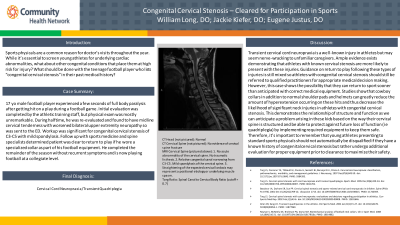Back

Clinical: General Topics
Congenital Cervical Stenosis – Cleared for Participation in Sports?
Friday, March 31, 2023
12:00 PM East Coast USA Time

- WL
William W. Long, Jr., DO (he/him/his)
Doctor of Osteopathic Medicine
Community Health Network
Fishers, Indiana, United States
Presenting Author(s)
Introduction: Sports physicals are a common reason for doctor’s visits throughout the year. While it’s essential to screen young athletes for underlying cardiac abnormalities, what about other congenital conditions that place them at high risk for injury? What should be done with the teenage football player who lists “congenital cervical stenosis” in their past medical history?
Case Study: 17 yo male football player experienced a few seconds of full body paralysis after getting hit on a play during a football game. Initial evaluation was completed by the athletic training staff, but physical exam was mostly unremarkable. During halftime, he was re-evaluated and found to have midline cervical tenderness with worsened bilateral upper extremity neuropathy so was sent to the ED. Workup was significant for congenital cervical stenosis of C3-C5 with mild spondylosis. Follow up with sports medicine and spine specialists determined patient was clear to return to play if he wore a specialized collar as part of his football equipment. He completed the remainder of the season without recurrent symptoms and is now playing football at a collegiate level.
Discussion: Transient cervical cord neuropraxia is a well-known injury in athletes but may seem nerve-wracking to unfamiliar caregivers. Ample evidence exists demonstrating that athletes with known cervical stenosis are more likely to present with these injuries, so it is vital that physicians make an informed decision for returning to play. Guidance on return to play following these types of injuries is still mixed so athletes with congenital cervical stenosis should still be referred to qualified practitioners for appropriate medical decision making. However, this case shows the possibility that they can return to sport sooner than anticipated with correct medical equipment. Studies show that cowboy collars in addition to normal shoulder pads and helmets can greatly reduce the amount of hyperextension occurring on these hits and thus decrease the likelihood of significant neck injuries in athletes with congenital cervical stenosis. This demonstrates the relationship of structure and function as we can anticipate a problem arising in these individuals based on the way their cervical spine is structured and be able to protect against future loss of function (ie quadriplegia) by implementing required equipment to keep them safe. It’s important to remember that young athletes presenting to standard sports physicals with congenital cervical stenosis should be further evaluated as they may be cleared to play with additional protective equipment.
Case Study: 17 yo male football player experienced a few seconds of full body paralysis after getting hit on a play during a football game. Initial evaluation was completed by the athletic training staff, but physical exam was mostly unremarkable. During halftime, he was re-evaluated and found to have midline cervical tenderness with worsened bilateral upper extremity neuropathy so was sent to the ED. Workup was significant for congenital cervical stenosis of C3-C5 with mild spondylosis. Follow up with sports medicine and spine specialists determined patient was clear to return to play if he wore a specialized collar as part of his football equipment. He completed the remainder of the season without recurrent symptoms and is now playing football at a collegiate level.
Discussion: Transient cervical cord neuropraxia is a well-known injury in athletes but may seem nerve-wracking to unfamiliar caregivers. Ample evidence exists demonstrating that athletes with known cervical stenosis are more likely to present with these injuries, so it is vital that physicians make an informed decision for returning to play. Guidance on return to play following these types of injuries is still mixed so athletes with congenital cervical stenosis should still be referred to qualified practitioners for appropriate medical decision making. However, this case shows the possibility that they can return to sport sooner than anticipated with correct medical equipment. Studies show that cowboy collars in addition to normal shoulder pads and helmets can greatly reduce the amount of hyperextension occurring on these hits and thus decrease the likelihood of significant neck injuries in athletes with congenital cervical stenosis. This demonstrates the relationship of structure and function as we can anticipate a problem arising in these individuals based on the way their cervical spine is structured and be able to protect against future loss of function (ie quadriplegia) by implementing required equipment to keep them safe. It’s important to remember that young athletes presenting to standard sports physicals with congenital cervical stenosis should be further evaluated as they may be cleared to play with additional protective equipment.
